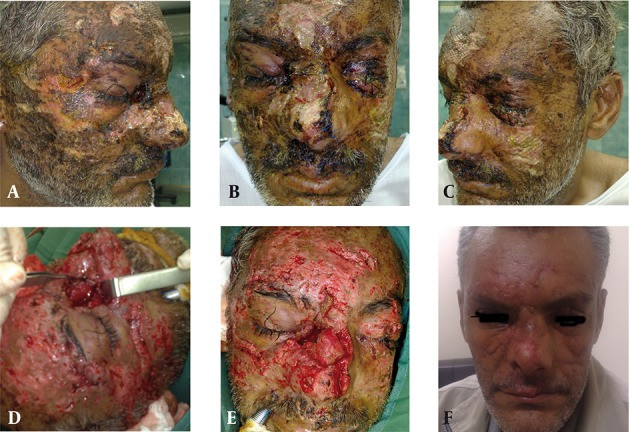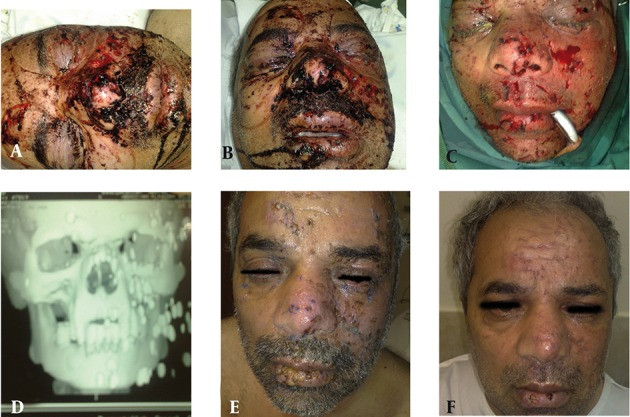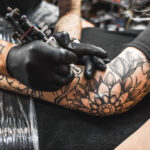Can You Put Silver Sulfadiazine On A Tattoo? Yes, silver sulfadiazine can be applied to a tattoo, particularly if it shows signs of infection or burns, as it’s an antimicrobial cream that helps prevent bacterial growth and promote healing. At tattooat.com, we aim to provide you with the essential information to care for your tattoos, and this guide dives into the specifics of using silver sulfadiazine on tattoos. This comprehensive article explores the proper application, benefits, and potential risks associated with using silver sulfadiazine on your tattoo to ensure you make informed decisions about tattoo aftercare, infection prevention, and optimal healing.
1. Understanding Silver Sulfadiazine and Its Uses
What is silver sulfadiazine, and what conditions is it typically used to treat? Silver sulfadiazine is a topical antimicrobial medication primarily used to treat burn wounds, preventing infection in second and third-degree burns. According to the U.S. National Library of Medicine, it works by releasing silver slowly, which is toxic to a wide range of bacteria and fungi. Its effectiveness in preventing infections makes it a common choice in burn centers and hospitals.
1.1. Composition and Mechanism of Action
What are the active components of silver sulfadiazine, and how do they combat infections? The active ingredient is silver sulfadiazine, which breaks down to release silver ions. These ions bind to bacterial DNA and cell membranes, disrupting cellular function and preventing the growth and proliferation of bacteria. This mechanism helps keep the wound sterile, allowing the body’s natural healing processes to occur without the interference of infection.
1.2. Common Medical Applications
Besides burns, what other medical conditions is silver sulfadiazine used for? Silver sulfadiazine is primarily used for burn wounds, but it can also treat skin grafts, pressure ulcers, and other skin conditions at risk of infection. Medical professionals often prescribe it when there is a need to prevent infection in damaged skin areas. It is particularly useful in situations where the risk of bacterial contamination is high.
2. Can You Use Silver Sulfadiazine on a New Tattoo?
Is it advisable to use silver sulfadiazine on a new tattoo? Generally, silver sulfadiazine is not recommended for routine aftercare of new tattoos unless there is a clear indication of infection or a burn. Regular tattoo aftercare typically involves gentle washing with mild soap and applying a thin layer of tattoo-specific or fragrance-free moisturizer. Using silver sulfadiazine without a specific need can interfere with the normal healing process.
2.1. Potential Benefits
Under what circumstances might silver sulfadiazine be beneficial for a new tattoo? Silver sulfadiazine can be beneficial if the new tattoo shows signs of infection, such as excessive redness, swelling, pus, or unusual pain. In these cases, the antimicrobial properties of the cream can help combat the infection and promote healing. It’s also useful if the tattoo has suffered a burn, as it prevents infection and aids in skin repair.
2.2. Risks and Side Effects
What are the potential risks and side effects of using silver sulfadiazine on a new tattoo? Potential risks include allergic reactions, which can manifest as rash, itching, or swelling. Prolonged use can also lead to silver absorption into the body, causing a condition called argyria, where the skin turns bluish-gray. Additionally, using it unnecessarily can disrupt the natural healing process and potentially affect the tattoo’s appearance.
2.3. Expert Opinions
What do tattoo artists and dermatologists say about using silver sulfadiazine on tattoos? Most tattoo artists and dermatologists advise against using silver sulfadiazine on new tattoos unless explicitly directed by a healthcare professional. According to Dr. Anna Patel, a dermatologist specializing in tattoo aftercare, “Using harsh antimicrobials can interfere with the ink settling process and may lead to fading or distortion of the tattoo.”
3. Identifying Tattoo Infections and Burns
How do you identify if a tattoo is infected or burned, and what are the key signs to look for? Identifying tattoo infections and burns early is crucial for proper treatment. Common signs of infection include:
- Excessive redness around the tattoo area
- Swelling and inflammation
- Pus or drainage from the tattoo
- Increased pain or tenderness
- Fever or chills (in severe cases)
Signs of a burn on a tattoo include:
- Blistered skin
- Severe pain
- Discoloration (redness or charring)
- Peeling skin
If you notice any of these signs, consult a healthcare professional or your tattoo artist immediately.
3.1. Common Causes of Tattoo Infections
What are the most common causes of tattoo infections, and how can they be prevented? Common causes of tattoo infections include:
- Unsterile Equipment: Using non-sterile needles or equipment during the tattooing process.
- Poor Hygiene: Inadequate handwashing or failure to keep the tattoo area clean.
- Contaminated Aftercare Products: Using lotions or ointments that contain bacteria.
- Environmental Contamination: Exposure to bacteria in the environment, especially in unclean settings.
Prevention methods include:
- Choosing a reputable tattoo artist who follows strict hygiene protocols.
- Following the aftercare instructions provided by your artist.
- Washing your hands thoroughly before touching the tattoo.
- Using only recommended aftercare products.
- Avoiding swimming pools, hot tubs, and other potential sources of contamination during the healing process.
3.2. Recognizing Tattoo Burns
How can you tell if a tattoo has been burned, and what factors contribute to tattoo burns? Tattoo burns can result from:
- Sun Exposure: Prolonged exposure to the sun without adequate protection.
- Laser Treatments: Improperly performed laser tattoo removal or skin treatments.
- Heat Sources: Contact with hot surfaces or excessive heat.
Recognizing a burn involves looking for signs like blistering, severe pain, and skin discoloration. Protecting your tattoo from the sun with sunscreen and avoiding heat sources can prevent burns.
3.3. When to Seek Professional Medical Advice
At what point should you seek professional medical advice for a tattoo infection or burn? Seek professional medical advice if you experience:
- Severe pain that doesn’t subside with over-the-counter pain relievers.
- Persistent fever or chills.
- Pus or drainage that is green, yellow, or foul-smelling.
- Spreading redness or swelling beyond the tattoo area.
- Blisters or open sores that don’t heal within a few days.
A healthcare professional can accurately diagnose the issue and recommend the appropriate treatment, which may include antibiotics or specialized burn care.
 Burn-blast Traumatic Tattoo
Burn-blast Traumatic Tattoo
4. How to Apply Silver Sulfadiazine on a Tattoo
If a healthcare provider recommends silver sulfadiazine for your tattoo, how should it be applied correctly? To apply silver sulfadiazine correctly, follow these steps:
- Wash Your Hands: Thoroughly wash your hands with soap and water to prevent introducing additional bacteria.
- Clean the Tattoo: Gently clean the tattoo area with mild, fragrance-free soap and water. Pat it dry with a clean, soft towel.
- Apply a Thin Layer: Using a clean applicator or your fingertip (ensure it’s clean), apply a thin layer of silver sulfadiazine cream to the affected area.
- Cover with a Sterile Bandage: Cover the tattoo with a sterile, non-stick bandage to protect it and keep the cream in place.
- Follow Doctor’s Instructions: Follow your healthcare provider’s instructions on how often to change the bandage and reapply the cream.
4.1. Dosage and Frequency
What is the recommended dosage and frequency of application for silver sulfadiazine on a tattoo? The typical recommendation is to apply a thin layer of silver sulfadiazine once or twice daily, or as directed by your healthcare provider. It’s crucial to follow their specific instructions, as the dosage and frequency may vary depending on the severity of the infection or burn.
4.2. Precautions During Application
What precautions should be taken during the application of silver sulfadiazine to ensure safety and effectiveness? Take the following precautions:
- Avoid Contamination: Use a clean applicator or clean hands to prevent contaminating the cream.
- Thin Layer: Apply only a thin layer to avoid suffocating the skin and hindering the healing process.
- Monitor for Reactions: Watch for signs of allergic reactions, such as rash, itching, or swelling.
- Avoid Sunlight: Protect the treated area from direct sunlight, as silver sulfadiazine can increase sensitivity to the sun.
4.3. Duration of Treatment
How long should you continue using silver sulfadiazine on a tattoo, and when should you stop? Continue using silver sulfadiazine for as long as your healthcare provider recommends. Typically, treatment lasts until the infection clears or the burn heals. Do not stop using the cream prematurely, even if the symptoms improve, unless instructed by a healthcare professional.
5. Alternative Treatments for Tattoo Infections and Burns
What are some alternative treatments for tattoo infections and burns if silver sulfadiazine is not suitable? If silver sulfadiazine is not suitable, alternative treatments include:
- Antibiotic Ointments: Over-the-counter or prescription antibiotic ointments like bacitracin or mupirocin.
- Wound Care Dressings: Specialized wound care dressings that promote healing and prevent infection.
- Aloe Vera: For minor burns, aloe vera gel can soothe the skin and promote healing.
- Prescription Antibiotics: In severe cases, oral or intravenous antibiotics may be necessary.
5.1. Over-the-Counter Options
What over-the-counter products can be used to treat minor tattoo infections or burns? Over-the-counter options include:
- Antibiotic Ointments: Bacitracin, Neosporin, or Polysporin can help prevent infection in minor cuts and burns.
- Antiseptic Washes: Mild antiseptic washes like Hibiclens can clean the area and kill bacteria.
- Aloe Vera Gel: Pure aloe vera gel can soothe minor burns and promote healing.
5.2. Prescription Medications
When are prescription medications necessary for treating tattoo issues? Prescription medications are necessary when:
- The infection is severe and doesn’t respond to over-the-counter treatments.
- The burn is deep or covers a large area.
- There are signs of systemic infection, such as fever or chills.
- The wound requires specialized care to prevent scarring or complications.
5.3. Natural Remedies
Are there any natural remedies that can help with tattoo infections or burns? Some natural remedies that may help include:
- Calendula: Calendula cream has anti-inflammatory and antimicrobial properties.
- Honey: Medical-grade honey can promote wound healing and prevent infection.
- Tea Tree Oil: Diluted tea tree oil has antiseptic properties, but use with caution as it can cause irritation in some people.
It’s important to consult with a healthcare professional before using natural remedies, especially if the infection or burn is severe.
 Dynamite particles under skin
Dynamite particles under skin
6. Proper Tattoo Aftercare to Prevent Infections and Burns
What are the essential steps for proper tattoo aftercare to minimize the risk of infections and burns? Proper tattoo aftercare is crucial for preventing infections and burns. Follow these steps:
- Keep the Tattoo Clean: Gently wash the tattoo with mild, fragrance-free soap and water 2-3 times a day.
- Apply Recommended Ointment: Use a tattoo-specific or fragrance-free moisturizer to keep the tattoo hydrated.
- Avoid Sun Exposure: Protect the tattoo from direct sunlight by wearing loose clothing or applying sunscreen.
- Stay Hydrated: Drink plenty of water to keep your skin hydrated and promote healing.
- Avoid Irritants: Avoid harsh chemicals, perfumes, and tight clothing that can irritate the tattoo.
6.1. Daily Cleaning and Moisturizing Routine
What should a daily cleaning and moisturizing routine for a new tattoo look like? A daily routine should include:
- Morning: Gently wash the tattoo with mild soap and water, pat dry, and apply a thin layer of moisturizer.
- Midday: If the tattoo feels dry, apply another thin layer of moisturizer.
- Evening: Wash the tattoo again, pat dry, and apply a final layer of moisturizer before bed.
6.2. Protecting Your Tattoo from the Sun
Why is it important to protect your tattoo from the sun, and what are the best methods for doing so? Sun exposure can cause tattoo fading, burns, and increased risk of skin damage. Protect your tattoo by:
- Wearing Protective Clothing: Cover the tattoo with loose-fitting clothing when outdoors.
- Applying Sunscreen: Use a broad-spectrum, high-SPF sunscreen (30 or higher) on the tattoo, even on cloudy days.
- Avoiding Peak Sun Hours: Limit your time in the sun during peak hours (10 AM to 4 PM).
6.3. Lifestyle Factors Affecting Tattoo Healing
What lifestyle factors can affect tattoo healing, and how can you manage them? Lifestyle factors that can affect healing include:
- Diet: Eat a balanced diet rich in vitamins and minerals to support skin health.
- Hydration: Drink plenty of water to keep your skin hydrated.
- Sleep: Get enough sleep to allow your body to repair and regenerate.
- Stress: Manage stress levels, as stress can impair the immune system and slow healing.
- Smoking and Alcohol: Avoid smoking and excessive alcohol consumption, as they can impair blood flow and delay healing.
7. Debunking Common Myths About Tattoo Aftercare
What are some common myths about tattoo aftercare that people should be aware of? There are several common myths about tattoo aftercare:
- Myth: Tattoos need to “breathe” and should not be covered.
- Fact: Covering a new tattoo with a sterile bandage protects it from bacteria and environmental contaminants.
- Myth: You should pick at scabs to speed up healing.
- Fact: Picking at scabs can lead to infection and scarring.
- Myth: All lotions are safe for tattoos.
- Fact: Use only fragrance-free, hypoallergenic lotions specifically recommended for tattoo aftercare.
- Myth: Sunscreen is only necessary on sunny days.
- Fact: UV rays can penetrate clouds, so sunscreen is necessary even on cloudy days.
7.1. The Truth About “Dry Healing”
What is “dry healing,” and is it a recommended method for tattoo aftercare? “Dry healing” involves letting the tattoo air dry without applying any moisturizer. This method is generally not recommended, as it can lead to excessive scabbing, cracking, and increased risk of infection. Keeping the tattoo moisturized promotes faster and more comfortable healing.
7.2. Are Homemade Aftercare Remedies Safe?
Are homemade aftercare remedies safe for tattoos, and what are the risks? Homemade aftercare remedies are generally not recommended, as they may contain ingredients that can irritate the skin or introduce bacteria. It’s best to stick to products specifically designed for tattoo aftercare or recommended by a healthcare professional.
7.3. When to Consult a Tattoo Artist
When should you consult your tattoo artist about issues with your tattoo? Consult your tattoo artist if you experience:
- Excessive redness or swelling.
- Unusual pain or discomfort.
- Changes in the tattoo’s appearance.
- Any concerns about the healing process.
Your tattoo artist can provide valuable advice and guidance based on their experience.
8. Tattoo Aftercare Products: What to Use and Avoid
What types of tattoo aftercare products are recommended, and which ones should be avoided? Recommended products include:
- Tattoo-Specific Balms: Products like Aquaphor, Tattoo Goo, or Hustle Butter are designed to promote healing and protect the tattoo.
- Fragrance-Free Moisturizers: Products like Cetaphil or Eucerin are gentle and won’t irritate the skin.
- Mild, Fragrance-Free Soaps: Products like Dr. Bronner’s Baby Unscented or Dove Sensitive Skin are suitable for cleaning the tattoo.
Products to avoid include:
- Products with Fragrances or Dyes: These can irritate the skin and cause allergic reactions.
- Petroleum-Based Products: These can clog pores and interfere with healing.
- Alcohol-Based Products: These can dry out the skin and delay healing.
8.1. Ingredients to Look For
What ingredients should you look for in tattoo aftercare products? Look for ingredients that:
- Hydrate the Skin: Such as glycerin, hyaluronic acid, or shea butter.
- Soothe Inflammation: Such as aloe vera, calendula, or chamomile.
- Protect Against Infection: Such as tea tree oil or vitamin E.
8.2. Ingredients to Avoid
What ingredients should you avoid in tattoo aftercare products? Avoid ingredients that:
- Cause Irritation: Such as fragrances, dyes, or alcohol.
- Clog Pores: Such as petroleum or mineral oil.
- Cause Allergic Reactions: Such as lanolin or parabens.
8.3. Product Recommendations
Can you recommend specific tattoo aftercare products that are safe and effective? Specific product recommendations include:
- Aquaphor Healing Ointment: A popular choice for its moisturizing and protective properties.
- Tattoo Goo Balm: A balm specifically designed for tattoo aftercare with natural ingredients.
- Hustle Butter Deluxe: A vegan balm with shea butter, mango butter, and coconut oil.
- Cetaphil Moisturizing Lotion: A gentle, fragrance-free lotion suitable for sensitive skin.
9. Understanding the Tattoo Healing Process
What are the different stages of the tattoo healing process, and what should you expect during each stage? The tattoo healing process typically involves these stages:
- Week 1: The tattoo will be red, swollen, and tender. Some oozing of ink and plasma is normal.
- Week 2: The tattoo will begin to scab. It’s important not to pick at the scabs.
- Week 3: The scabs will start to fall off, and the tattoo may look milky or cloudy.
- Week 4 and Beyond: The skin will continue to heal, and the colors will become more vibrant.
The entire healing process can take anywhere from 2 to 4 weeks, depending on the size and location of the tattoo.
9.1. Factors Affecting Healing Time
What factors can affect the healing time of a tattoo? Factors that can affect healing time include:
- Size and Location: Larger tattoos and those in areas with more friction may take longer to heal.
- Skin Type: People with sensitive skin may experience slower healing.
- Overall Health: A healthy immune system promotes faster healing.
- Aftercare Routine: Proper aftercare can significantly impact healing time.
9.2. Common Healing Issues and Solutions
What are some common issues that can arise during tattoo healing, and how can they be addressed? Common issues include:
- Itching: Apply a thin layer of moisturizer to relieve itching.
- Redness and Swelling: This is normal in the early stages, but excessive redness or swelling may indicate an infection.
- Scabbing: Avoid picking at scabs and keep the area moisturized.
- Infection: Seek medical attention if you suspect an infection.
9.3. Recognizing Normal vs. Abnormal Healing
How can you tell the difference between normal and abnormal tattoo healing? Normal healing involves redness, swelling, and scabbing that gradually subsides over time. Abnormal healing involves signs of infection, such as excessive pain, pus, or fever. If you’re unsure, consult a healthcare professional or your tattoo artist.
10. When to Seek Professional Help for Tattoo Complications
In what situations should you seek professional medical help for tattoo complications? Seek professional medical help if you experience:
- Signs of infection, such as pus, fever, or spreading redness.
- Severe pain that doesn’t subside with over-the-counter pain relievers.
- Allergic reactions, such as rash, itching, or swelling.
- Any concerns about the healing process.
10.1. Types of Medical Professionals to Consult
What types of medical professionals should you consult for tattoo-related issues? You can consult:
- Dermatologist: A skin specialist who can diagnose and treat skin conditions, including tattoo infections and allergic reactions.
- Primary Care Physician: Your general doctor can assess the issue and refer you to a specialist if necessary.
- Infectious Disease Specialist: If the infection is severe or doesn’t respond to initial treatment, an infectious disease specialist may be needed.
10.2. Questions to Ask Your Doctor
What questions should you ask your doctor when seeking help for tattoo complications? Ask questions such as:
- What is causing the issue?
- What treatment options are available?
- What are the potential risks and side effects of the treatment?
- How long will it take for the tattoo to heal?
- What aftercare steps should I follow?
10.3. Documenting Your Tattoo Healing Journey
Why is it helpful to document your tattoo healing journey, and how can you do it? Documenting your tattoo healing journey can help you track progress, identify potential issues, and provide valuable information to your healthcare provider if complications arise. You can do this by:
- Taking Photos: Take daily photos of the tattoo to monitor changes.
- Keeping a Journal: Write down any symptoms, treatments, and concerns.
- Tracking Products Used: Keep a record of the aftercare products you use.
This information can be invaluable in ensuring your tattoo heals properly and remains a beautiful piece of art for years to come.
At tattooat.com, we understand the importance of proper tattoo aftercare. We offer a comprehensive guide to help you navigate the healing process and keep your tattoos looking their best. Explore our website for more articles, artist spotlights, and design inspiration.
Address: 1825 SW Broadway, Portland, OR 97201, United States
Phone: +1 (503) 725-3000
Website: tattooat.com
FAQ: Silver Sulfadiazine and Tattoo Care
1. Can I use silver sulfadiazine on my infected tattoo?
Yes, silver sulfadiazine can be used on an infected tattoo, but only if recommended by a healthcare professional. It is an antimicrobial cream that helps prevent bacterial growth and promote healing.
2. How often should I apply silver sulfadiazine on my tattoo?
Apply silver sulfadiazine once or twice daily, or as directed by your healthcare provider. Follow their specific instructions for the best results.
3. What are the side effects of using silver sulfadiazine on a tattoo?
Potential side effects include allergic reactions (rash, itching, swelling), skin discoloration (argyria), and disruption of the natural healing process.
4. Can silver sulfadiazine help with tattoo burns?
Yes, silver sulfadiazine can help with tattoo burns by preventing infection and aiding in skin repair. Consult a healthcare provider for proper treatment.
5. Is it safe to use silver sulfadiazine on a new tattoo as a preventative measure?
No, it is generally not recommended to use silver sulfadiazine on a new tattoo unless there is a clear indication of infection or a burn.
6. What should I do if I experience a rash after applying silver sulfadiazine on my tattoo?
Stop using the cream immediately and consult a healthcare professional. You may be experiencing an allergic reaction.
7. Can I buy silver sulfadiazine over the counter?
No, silver sulfadiazine is a prescription medication and requires a prescription from a healthcare provider.
8. How long should I continue using silver sulfadiazine on my tattoo?
Continue using silver sulfadiazine for as long as your healthcare provider recommends, typically until the infection clears or the burn heals.
9. What are some alternative treatments for tattoo infections if I can’t use silver sulfadiazine?
Alternative treatments include antibiotic ointments, wound care dressings, aloe vera, and prescription antibiotics. Consult a healthcare provider for the best option.
10. Should I cover my tattoo after applying silver sulfadiazine?
Yes, cover the tattoo with a sterile, non-stick bandage to protect it and keep the cream in place, unless otherwise directed by your healthcare provider.
Ready to explore stunning tattoo designs, find talented artists, and learn everything about tattoo aftercare? Visit tattooat.com today and start your tattoo journey with confidence. Discover endless inspiration and expert advice tailored to your unique style and needs.

